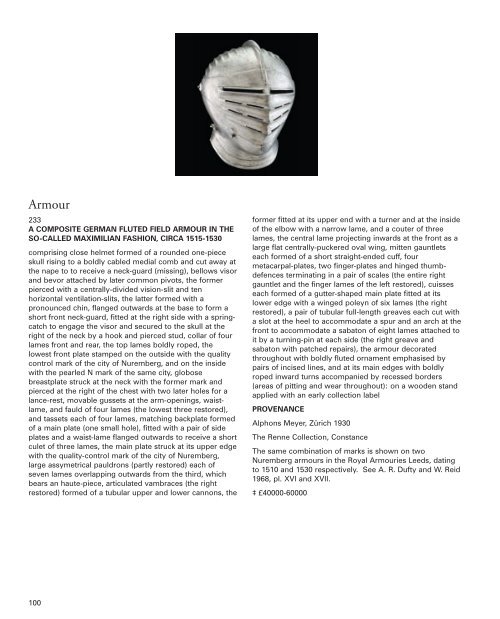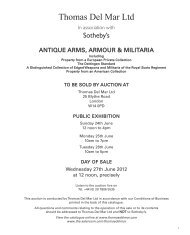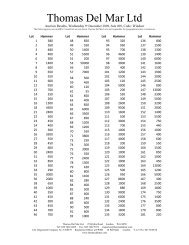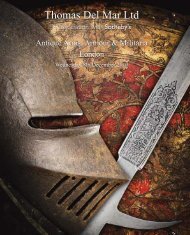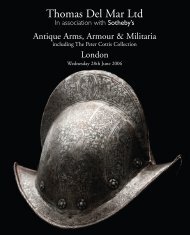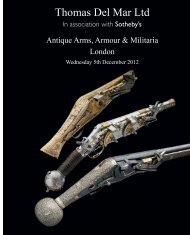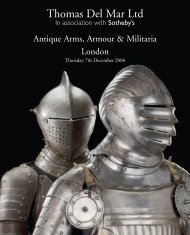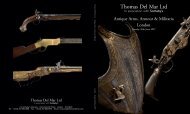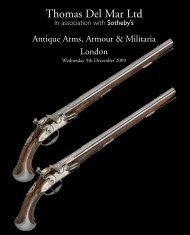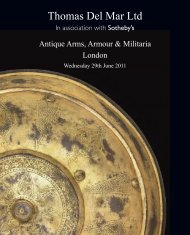Antique Arms, Armour & Militaria - Thomas Del Mar
Antique Arms, Armour & Militaria - Thomas Del Mar
Antique Arms, Armour & Militaria - Thomas Del Mar
Create successful ePaper yourself
Turn your PDF publications into a flip-book with our unique Google optimized e-Paper software.
<strong>Armour</strong><br />
233<br />
A COMPOSITE GERMAN FLUTED FIELD ARMOUR IN THE<br />
SO-CALLED MAXIMILIAN FASHION, CIRCA 1515-1530<br />
comprising close helmet formed of a rounded one-piece<br />
skull rising to a boldly cabled medial comb and cut away at<br />
the nape to to receive a neck-guard (missing), bellows visor<br />
and bevor attached by later common pivots, the former<br />
pierced with a centrally-divided vision-slit and ten<br />
horizontal ventilation-slits, the latter formed with a<br />
pronounced chin, flanged outwards at the base to form a<br />
short front neck-guard, fitted at the right side with a springcatch<br />
to engage the visor and secured to the skull at the<br />
right of the neck by a hook and pierced stud, collar of four<br />
lames front and rear, the top lames boldly roped, the<br />
lowest front plate stamped on the outside with the quality<br />
control mark of the city of Nuremberg, and on the inside<br />
with the pearled N mark of the same city, globose<br />
breastplate struck at the neck with the former mark and<br />
pierced at the right of the chest with two later holes for a<br />
lance-rest, movable gussets at the arm-openings, waistlame,<br />
and fauld of four lames (the lowest three restored),<br />
and tassets each of four lames, matching backplate formed<br />
of a main plate (one small hole), fitted with a pair of side<br />
plates and a waist-lame flanged outwards to receive a short<br />
culet of three lames, the main plate struck at its upper edge<br />
with the quality-control mark of the city of Nuremberg,<br />
large assymetrical pauldrons (partly restored) each of<br />
seven lames overlapping outwards from the third, which<br />
bears an haute-piece, articulated vambraces (the right<br />
restored) formed of a tubular upper and lower cannons, the<br />
former fitted at its upper end with a turner and at the inside<br />
of the elbow with a narrow lame, and a couter of three<br />
lames, the central lame projecting inwards at the front as a<br />
large flat centrally-puckered oval wing, mitten gauntlets<br />
each formed of a short straight-ended cuff, four<br />
metacarpal-plates, two finger-plates and hinged thumbdefences<br />
terminating in a pair of scales (the entire right<br />
gauntlet and the finger lames of the left restored), cuisses<br />
each formed of a gutter-shaped main plate fitted at its<br />
lower edge with a winged poleyn of six lames (the right<br />
restored), a pair of tubular full-length greaves each cut with<br />
a slot at the heel to accommodate a spur and an arch at the<br />
front to accommodate a sabaton of eight lames attached to<br />
it by a turning-pin at each side (the right greave and<br />
sabaton with patched repairs), the armour decorated<br />
throughout with boldly fluted ornament emphasised by<br />
pairs of incised lines, and at its main edges with boldly<br />
roped inward turns accompanied by recessed borders<br />
(areas of pitting and wear throughout): on a wooden stand<br />
applied with an early collection label<br />
PROVENANCE<br />
Alphons Meyer, Zürich 1930<br />
The Renne Collection, Constance<br />
The same combination of marks is shown on two<br />
Nuremberg armours in the Royal <strong>Armour</strong>ies Leeds, dating<br />
to 1510 and 1530 respectively. See A. R. Dufty and W. Reid<br />
1968, pl. XVI and XVII.<br />
‡ £40000-60000<br />
100


